Contributed by The Grammar Fuhrerin
This blog contains some of the stories I have collected over my one-month vacation in Egypt.
This is Part 2 of my 3-Part blog chronicling my Enigmatic Egyptian experience.
Also read: Trip to Egypt: Exploring Giza & Cairo for a Day
Adam’s best friend’s home
On our first weekend night in Egypt, Anas’s (Adam’s best friend) family invited us for dinner at their home in Alexandria.
Momentarily forgetting what I’d read about Alexandria, a coastal city famous for its fresh seafood (besides other conqueror-related things), we had to drop by a pharmacy between the 2-hour drive from Tanta to Alex, just so I could eat as much shrimps as I wanted without a severe allergy attack.

Shrimps are LIFE!
When we arrived at the family flat, we were invited to sit and rest at the salon, where I sat for approximately 5 minutes before getting up the courage to ask for the washroom.
I was then led to the inner part of the house, separated from the living and dining rooms with a thick curtain.
Inside, the women were very busy in the kitchen.
The lady of the house was Anas’s mother.
She wore a niqab (a type of veil worn by women to cover the whole face save for the eyes), and so did her eldest daughter, Eptehal, who was married with two young boys.
Her youngest daughter, Maryam, was in her late teens and sported a coloured hijab.
Outside, the men were catching up with each other in Arabic: Adam, Anas, and Anas’s two younger brothers, Malek and Medo, and his brother-in-law, Islam. That brought the whole family up by 9.
Plus me and Adam and his mother and the grand total was 12 — twice the number of the family’s 6-seater dining table.
When the food was ready, the three of us guests sat one side, and Islam, Anas, and Malek sat on the opposite side. We feasted on grilled fish, fried fish, steamed shells, savoury shrimps, and dips and sauces and salads.

Halwa-Halwa!
I was in paradise!
— At least until I started puffing up because I’d forgotten to take my anti-histamines (again). The women and children did not join us. They ate behind the curtains and only emerged afterwards to clean the table.
The elder of the two kids ended up locking himself in the washroom. In her hurry to come to her son’s rescue, Maryam forgot to put on her niqab.
She kept laughing at her son’s expense as she searched for the keys. I think everyone was laughing except the poor kid. After tea, I was invited to the inner part of the house to sit with the ladies. They were so much more relaxed behind closed doors.
Niqabs untied, faces unveiled, smiling and welcoming – not at all what I had stereotyped Arab women to be. I learned a new word that night too.
“Mabsoota.”
The women drew a line across their lips, and I stupidly thought they were asking for the brand of my lipstick.
“Are you happy?” Maryam translated for her mother and elder sister.
“Yes, I am mabsoota.”
Hanoville Beach, El Agamy

Described as the Marbella or even St. Tropez of Egypt’s Mediterranean coast, Hanoville Beach, one of El Agamy’s many beaches, was a beautiful but deserted seaside town in the winter.
On 30 Dec 2016, we boarded a train from Tanta to Alexandria, disembarked from the train station downtown, and proceeded to our rented flat a stone throw’s away from Hanoville Beach.
It wasn’t until 8 in the evening when we finally got settled in, so we had to wait the next morning to admire the beach next door.
Adam’s Mama and I decided to sneak out of the house and take a late morning walk, except we didn’t quite look the part.
We did not wear wide-rimmed sun hats and floral-printed summer dresses.
It was 10 degrees outside, so our beach outfits consisted of multiple layers of clothes beneath heavy winter jackets.
We went as close to the water as possible, and I had to remind myself that what I was looking at was no ordinary water. It was THE Mediterranean Sea.

Mama and I picked seashells and breathed in the salty fresh air before hailing a cab to go to the market.Our cabbie could speak decent English, so whenever Mama and I stumbled on a language problem (an inevitability whenever Adam was not around), he translated for us.
“She’s asking if you want fuul (baked beans) and falafel (fried vegetable balls) for breakfast,” and “She’s asking if you want fish and shrimps for lunch.”

Oh boy, do I!
Mohamed was a very friendly cabbie. He agreed to take us around the town market to get fresh bread and fish and beans.
Afterwards, he dropped us in front of our rented flat (even though I was sure Mama forgot the way back, because so did I) and gave his mobile number in case we needed a quick ride.
Adam (who had woken up while we went food shopping) and I took another walk on the beach after breakfast.
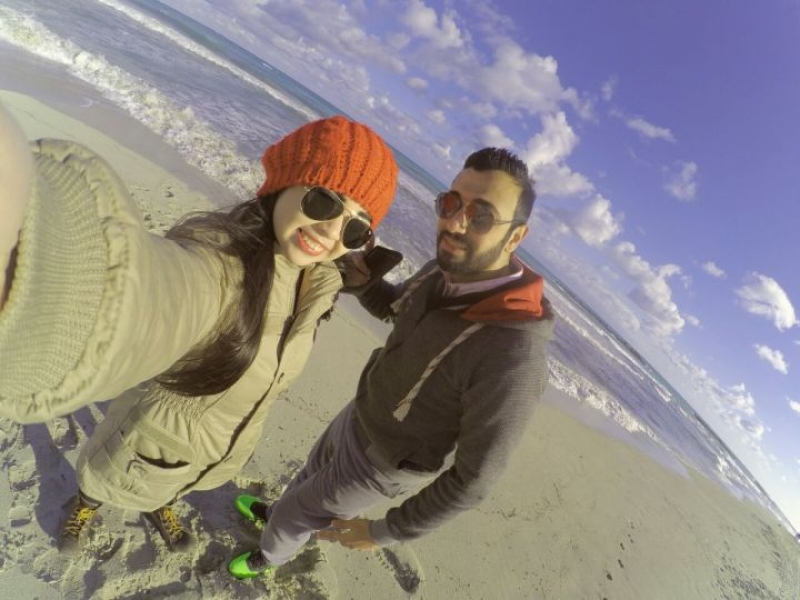
Mama stayed home to catch up on her favourite Indian and Turkish series on TV. We took jump shots in front of the sea.

Adam’s was a bit of a then-and-now shot, having taken jump shots on the same beach a few years before.

I scooped up some sand into a plastic cup, while he drew on the sand.

San Stefano Grand Plaza

For New Year’s Eve, Adam, his Mama, and his best friend Anas, and I headed up to San Stefano to witness the fireworks display.
We were stuck in the 10 o’clock traffic and inched our way to the mall complex where we found it to be completely and uncomfortably packed.
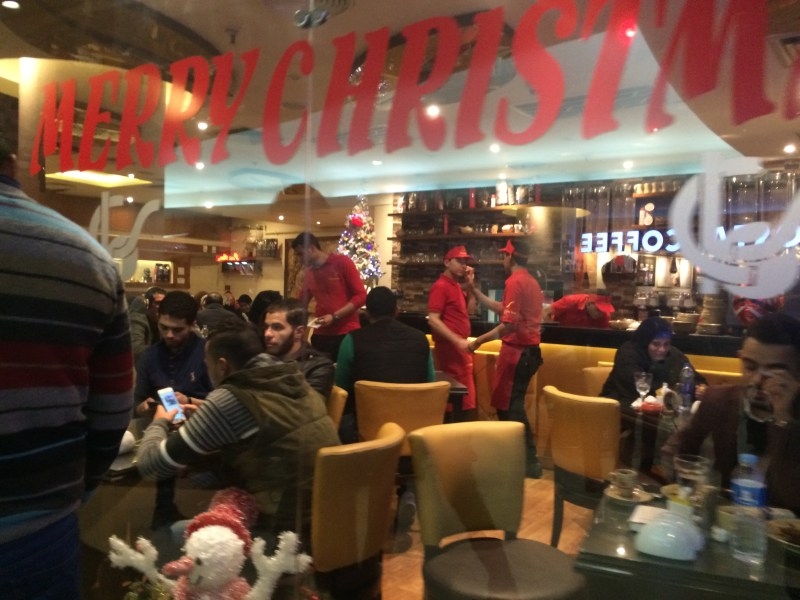

Instead of riding the elevator to the rooftop, we just decided to head back to the car and cruise along the corniche.
But by the time we got out of the basement parking lot, it was already 5 minutes ’til midnight.
Traffic was bumper to bumper, as Alexandrians abandoned the pedestrian lanes and zigzagged between stranded cars to catch the fireworks.

Adam grabbed my hand and opened the car door, and we followed the crowds to where the action was.
Fireworks exploded from the top of the Four Seasons Hotel marking the beginning of 2017. It was a street party with singing and dancing and an overall atmosphere of celebration.

Impromptu dance showdown. Egyptians doing it right (again).
Not long after, it stated to rain.
Adam and I zigzagged our way back to Mama and Anas who were still stuck in traffic. Once safely back inside the car, we kissed and hugged each other a very Happy New Year, and dropped by Muntazah Park before heading home to El Agamy.
Roman Ampitheatre

On New Year’s morning, Adam and I took a mini bus downtown to explore the ruins of the Roman Ampitheatre. It was not just like being transported back in time, but it felt like being transported to a different place altogether.

The Roman Ampitheatre was not located in a remote part of the city. It was a two-minute walk from the main train station.

Having never been to Rome, I was more than a little giddy to explore a slice of the Eternal City.
There were more than enough remnants of Roman columns, courtyard mosaics, and marble baths and archways to recreate the past, if only in the mind’s eye.


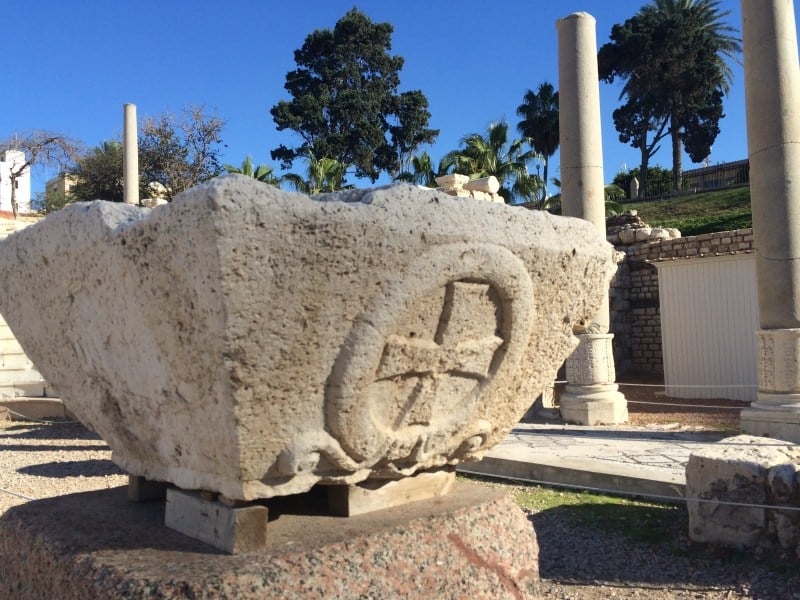
In the middle of the ampitheatre’s remaining crescent structure was a smooth block of stone.

Which, Adam discovered, carried the speaker’s voice across the entire space.

It should not have been surprising considering the ampitheatre was used as a theatre and public hall during the Roman, Byzantine, and Early Islamic eras. It was then completely forgotten until its accidental discovery in 1960.
The urge to recite the lyrics to Bruno Mars’ “24K” was much too strong.

24 Karat magic in the aaaiiirrr…
We also explored what was left of the rooms below the marble theatre seats.

Some areas were locked with rusty iron gates, but for the most part, we were given free rein to wander around the area. A group of Cairenes started chatting with Adam, and he told them about the cool acoustic feature in the middle of the ampitheatre.

So the four of them raced each other to try it out. When they were out of earshot, I teased Adam about taking his tour guide tip.
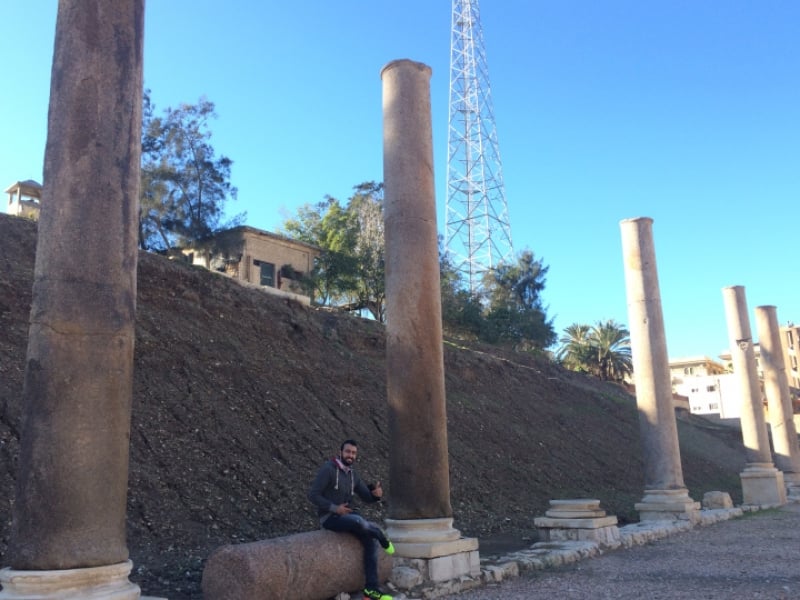
It was 2 when we finally left the ampitheatre. We ducked into a nearby restaurant and ordered koshary for brunch.

Koshary is an Egyptian dish made of rice, macaroni, and lentils, topped with spiced tomato sauce and garlic vinegar, and garnished with chickpeas and crispy fried onions.
As we dug in our bowls, a middle-aged Egyptian man eyed us curiously and expressed his concern over a five-foot Asian girl eating koshary.
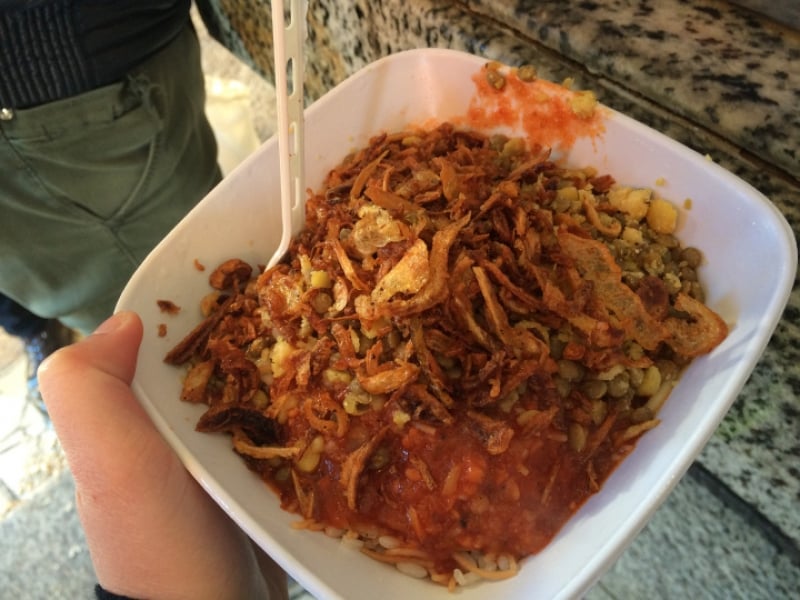
“Isn’t that too heavy for her?” he asked in Arabic.
“Don’t worry,” Adam told him. “She eats anything.”
Kom El Shokafa Catacombs

Of all the places I have visited in Egypt, the Catacombs was my favourite. It was rarely ever mentioned in the travel blogs I had read (pre-travel research game on).
I only read about it in an outdated travel book from a secondhand bookstore, briefly described as an archaeological site featuring a unique intermarriage of Egyptian, Greek, and Roman influences, and accompanied by a photograph of a dimly-lit entryway with stone carvings of Medusa, Sobek, and Hermes’ caduceus.
Basically, it was a mythology fan’s Disneyland.
So after Adam and I finished our koshary brunch, we caught up with Anas who hailed us a cab to the Catacombs.

Yellow cabs parked outside the Alexandria Train Station
The cabbie was in his 80s, chainsmoked his way through downtown traffic, and greeted me, “Welcome Egypt!” at least five times.
He dropped us off outside the gates of a suspiciously non-Catacomb-like place. Inside, Adam had already paid for our tickets when I read “Pompey’s Pillar” plain and simple on the glass booth.
Also read: Solo in Egypt: 7-Day Itinerary and Costs
My heart dropped. It was already 4 o’clock, and I was about to resign myself to never seeing Mythology Disneyland, when a miracle happened: the lady at the ticket booth informed us that the Catacombs was only a short distance away.
She graciously returned our money, and Adam and Anas and I wasted no time taking the 15-minute walk uphill. We passed by a thickly residential area in Alexandria where tuktuks (a three-wheeled taxi driven by a motorcycle) blasted upbeat Arabic songs to attract potential passengers.

When we reached the end of the narrow street, we saw the wide open gates of the Kom El Shokafa Catacombs.

The courtyard looked deserted, and I was afraid they had already closed for the day. But the man behind the booth said they closed at 5, which meant we still had three quarters of an hour for otherworldly exploration.
On the surface, it looked like a random display of marble artifacts – columns, archways, and empty sarcophagi.
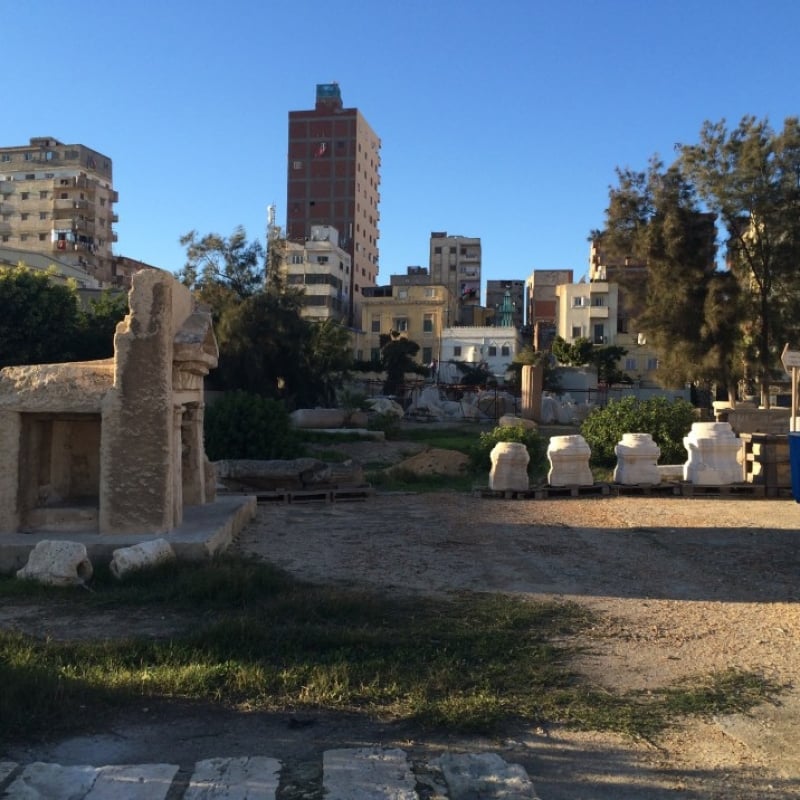

In the absence of a resident tour guide, it took us more time than was necessary to find the entrance to the underground, but when we finally did, the discovery was all the more rewarding.
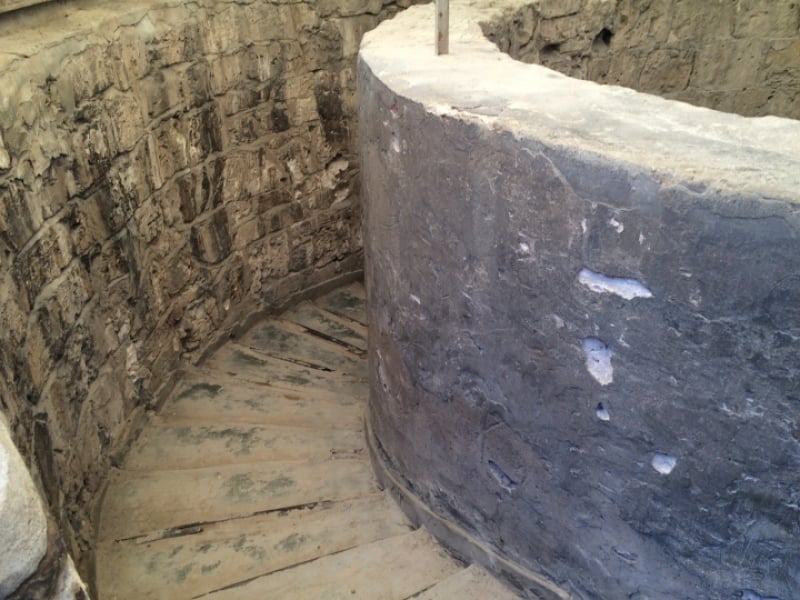
Adam led the group down the spiral staircase. I switched on my action camera and recorded the whole thing on video. And Anas followed right behind us (I suspect he was the most nervous one too).
As we went deeper, it became harder and harder to see. I kept my eyes peeled for the Catacombs’ main archway, but so far, all we’d seen were empty chambers and passageways too narrow for an adult to squeeze into.
Then we heard voices coming from one of the chambers. A middle-aged man in a dark suit was explaining to two Japanese tourists how the natural waterproof ceiling worked. I joined the group and listened.
Here was our longed-for tour guide, and he, sensing that Adam and Anas and I were eager listeners, led us right to the entrance of the Catacombs.


I could not believe it!
I wanted to jump for joy – except that I couldn’t because I was in an actual tomb and doing so would be tantamount to desecration. The tour guide introduced himself as Mahmoud. He was a Greco-Roman historian who had studied the field for almost 20 years.
He forbade all forms of photography, but ever since the decline of tourism in Egypt and the ever dwindling number of visitors in the Catacombs, he granted us permission to take as many photos and videos as we wanted, on one condition: that we would upload everything on Facebook to increase public interest in Kom El Shokafa.

Sir, Yes Sir!
He did most of the tour in Arabic.
By then, the two Japanese tourists had disappeared out of sight, and it was just us four living souls down there. Adam translated some bits of Mahmoud’s explanation, but mostly played the part of the over-attentive pupil. Anas kept glancing over his shoulder, visibly more uncomfortable as we went deeper underground.
The Catacombs consisted of three levels, each one built (or “carved” – as Mahmoud firmly corrected me. “Nothing in the Catacombs was built. They were carved.”) on top of the other.

Abandon all hope ye who enter here.
The lowest level is the oldest and remains inaccessible to this day due to its high water level.
The second level has only been recently accessed, though flooding is commonplace (as Adam learned later on when he ruined his brand new sneakers with what I called “Dead people water.”) And the first level was the one closest to the surface, the “newest” (at least in relative terms), and the one adorning a curious mixture of Egyptian, Greek, and Roman elements.

Kom El Shokafa literally means “Mound of Shards,” its name referring to the heaps of broken pottery on site when it was first discovered. Way back when the Catacombs’ departed residents still had living relatives who visited them, the visitors would bring food and drink to “share” with the dead.
But when the meal was over, the superstitious refused to carry the empty pots back to the land of the living, so they smashed and left them there until the Catacombs’ discovery in the early 20th century.
With bones of a long dead horse still in one of the chambers, it seemed as though the tradition of burying the dead with their prized possessions remained long after Egypt’s pyramid age.

“Isn’t it strange that the tour guide keeps disappearing?” Adam asked.
By then, we had wandered through at least ten different underground chambers with Mahmoud nowhere in sight.

Maybe it was the darkness or the poor ventilation or even just the knowledge that it was almost closing time (and spending the night in a necropolis was not part of the itinerary), but the longer we stayed, the more creeped out I felt. And Adam started doing a poor impersonation of a mummy.

— Which was an obvious anachronism considering the Catacombs was built during 2nd or 3rd century A.D., long after Egyptians mummified their dead. But I was still scared shitless. I was relieved when Mahmoud finally reappeared and told us that they were about to close. We met him back on the surface where he gamely agreed to take a groupie with us.

Alexandria Library

The Alexandria Library that stands on the Mediterranean seashore today is not the Alexandria Library that was built during Ptolemaic Dynasty whose most famous ruler was also its last, Queen Cleopatra VII.
The original structure had long since been destroyed by a series of wars and fires, and the modern one built in 2012 is but a commemoration of its glorious past. Still, it was built on a plot of land which is believed to be near the site where the ancient library once stood.

Either way, it was worth a visit. Adam and I left El Agamy at noon and reached downtown an hour later. The library put several security measures, so that the place had a overall feeling of an airport.
We had to take off our jackets and shoes, for crying out loud! Once inside, we were too restless to read. So yes, I am ashamed to admit that I did not read a single book in the Alexandria Library.

Does sitting on one count?
Adam wanted to see the famous military uniform which the late Egyptian President Anwar Sadat wore when he was assassinated. Now, a bit of a background story: Sadat is Adam’s hero.
End of background story.
He was practically hyperventilating when we’d finally located the museum on the basement. It was a small room as far as museums go. It featured the distinguished life of President Sadat in chronological order, from his childhood, early military career, marriages and families, political achievements, and finally, his death.
I joined an English-speaking tour guide who had just started giving a group of Europeans an insightful explanation of Sadat’s personal memorabilia.

Adam proceeded directly to the death uniform, blood-stained and bullet-holed, and encased in glass. When I started pounding him with questions, he herded me back towards the tour group (which I’d left because a Spaniard kept asking too many questions).
Sadat was portrayed as a peace-loving president who granted amnesty to members of the Muslim Brotherhood and signed the Camp David Accords with Israel. The latter decision was said to be the main incitement for his assassination in a military parade in 1981 at the hands of Islamic extremists.

“But why? Where was the military?” I blurted out before I could stop myself.
“They were the military,” the female tour guide patiently explained, highlighting the leader of the assassins, Khalid Islambouli, who was a lieutenant.
Plot twist!
— Albeit a 35-year-old one but a plot twist to me, nonetheless, who still has very little knowledge of contemporary Egyptian history. When the European tourists left, the tour guide secretly handed me and Adam semi-glossy Sadat pamphlets as keepsakes.
Afterwards, we visited the Antiquities Museum, one of the rare museums in the world housing artifacts discovered on the very site on which it was built. In addition to its Pharaonic, Coptic Christian, and Medieval Islamic collection, it also contained Greco-Roman sculptures hauled from the nearby Mediterranean seabed.
Citadel of Qaitbay

The Citadel is a defensive fortress which dates back to the Middle Ages, but its history runs even further back. It was built on Pharos Island, on the exact same spot of the Pharosn Lighthouse, one of the Seven Great Wonders of the Ancient World.
Like the ancient library, Pharos Lighthouse, the pride of Ptolemaic Alexandria, had long since been reduced to rubble. Over a century after its destruction, Sultan Qaitbay built the Citadel to protect northern Egypt from the Ottoman Turks.
Recent renovations on the site (which no longer serves any military function in the present day) beckons visitors to a sweeping view of the Mediterranean Sea.

That is, if they cared to climb a few stone steps to the roof deck.
— Something I was not all too keen of doing when we visited it after another heavy bowl of koshary.
When Adam, Anas and I arrived, it was only 15 minutes before closing time.

We ran past the courtyard, only pausing to take a few photos, and entered the fortress’s main threshold.
The ground floor contained a high-ceilinged mosque, a deep well, and a room with a small pit which must have served as a toilet. Coming up a long flight of uneven, large-gapped stone steps was a hallway with narrow slits for windows and (gasp!) a security guard who shooed us out of the premises, because it was officially closing time.
Adam led the way down and urged us (well, mostly me) to run faster than my koshary-filled belly allowed. Instead of going straight to the courtyard and out of the citadel, he swerved right and climbed another flight of stairs to the roof deck.
The same security guard caught us red-handed once more, so while he was busy shooing other more law-abiding tourists, we posed for photos until we pushed the poor guy past his breaking point.

Saint Catherine’s Cathedral

There was a local woman selling roses outside the Citadel of Qaitbay. Adam, who has the heart of a marshmallow, bought one and gave it to me. Much as I appreciated the gesture, holding a rose while touring Alexandria on a rainy afternoon was more than a little inconvenient.
We were still miles away from the main road when a hantoor driver asked us where we were going. “To Saint Catherine’s Cathedral,” Adam said.
So we rode in style to our last stop for the day.


It’s called a public display of affection. Don’t ask.
Having missed Sunday mass the previous day, the plan was for Adam and Anas to drop me off at the gates and shop at a nearby souq.
It was a safety measure; following the recent suicide bombing of a Coptic Orthodox Church in Cairo, authorities stationed outside the churches were on red alert. Adam and Anas, both practising Muslims, did not want to draw unnecessary attention.
When we reached Saint Catherine’s, Adam spoke to one of the men inside, explaining that I was a Roman Catholic who wanted to hear Mass. The man responded by admitting all three of us, and we walked past the long avenue of trees between the gate and the church.

We were already struck by how beautiful the church facade was. But no one was prepared for what we were about to see inside.

Enter choir of angels beat boxing heavenly songs of praise
Beside the door was a statue of St. Catherine of Alexandria herself, recognisable by the spiked breaking wheel which miraculously failed to kill her.

On the other side of the door was Our Lady holding the child Jesus to whom I offered the rose from the Citadel. With only three people praying on the church pews, I led Adam and Anas on a tour around the Cathedral.
— Not that I knew where I was going, but being Catholic, I had a general idea. I pointed out the Baptistry.

The marble fountain is adorned with a small figure of St. John.
I showed them the small chapels on the east and west wings with life-size statues of St. Joseph and the Sacred Heart of Jesus.


There was also an elaborate nativity set complete with the Holy Family, the Angels, the Shepherds, and the Three Kings.

I bugged Adam into asking the man preparing the altar table what time the Mass was and in what language it would be said.
He said at 6.30, an Arabic Mass would be said by one of the Franciscans, and that it would only last for half an hour being an ordinary weekday Mass, and that I should join them. In the meantime, we still had a full hour until it started, so why not see the incorruptible body of Saint Sabine?
“She’s here?” I asked. “Yes, she is in one of the chapels,” he said, already leading us to where the body was.

Saint Sabine was a 4th Century Roman martyr. Her body was discovered over 1,300 years after her death, undecayed and fully intact.

Pope Gregory XVI granted the sacred relic to an Italian consul’s wife who, at that time, resided in Alexandria. She, in turn, pledged the body to the newly-built Saint Catherine’s.
Ra’fat, our impromptu tour guide, also showed us the back of the main altar where no less than an Italian King was buried.

Victor Emmanuel III ruled Italy during the first half of the 20th Century before abdicating the throne in favour of his son.
He went into exile in Alexandria where he died the following year. Just when Mass about to start, Adam and Anas excused themselves, saying they left the car parked outside (which wasn’t true but they felt that they had already outstayed their welcome).
Despite Ra’fat’s hospitality, they still felt like trespassers, and that if their true identities were found out, they would be thrown out of the Church. The Cathedral was empty save for only three other people: an elderly woman, a young woman, and an elderly man. None of them were related.

The elderly woman approached me, told me to sit closer to the altar, and gave me an Arabic hymnal. I told her I didn’t speak (much less sing) Arabic but thanked her anyway. Ra’fat, bless his foresight, gave me a French Missal which helped me tremendously to follow the Order of the Mass.
After recessional, the elderly man shook my hand and asked me in straight English whether they would be seeing me again at church soon. I said no, that I was leaving Alexandria the next day, but that I had always wanted to visit Saint Catherine’s before flying back to Dubai.
So he wished me well and left. The two women stayed behind to collect the hymnals. The younger woman greeted me in Arabic. When I smiled and asked her gently what she meant, she took a few seconds to think it over and said, “Happy New Year!”
I shook hands and said goodbye to Ra’fat before meeting Adam and Anas outside. They still had not gotten over everything that they had just seen in the Cathedral.
I told Adam that there was no reason for them to be afraid in the first place. “Nobody got kicked out of church simply for not being Catholic.”
But he said that the situation after the Cairo attack was different. And maybe he was right. Then again, maybe he wasn’t.
Because if I had been as careful as he wanted me to be, how would we have known what Saint Catherine’s had in store for us?

A 19th century painting of Saint Catherine of Alexandria depicted as a divinely-inspired scholar who debated with her pagan opponents.
Stanley Bridge

On our last night in Alexandria, Anas, Adam, and I cruised along the corniche road. We passed by many popular landmarks like the San Stefano Grand Plaza, Alexandria Library, Cecil Hotel, and Monument of the Unknown Soldier.
We also happened to pass by the hospital where Adam was born and the beach where he learned to swim. Then we passed by Stanley Bridge. It was our third time to visit it. The first time was right after we had dinner with Anas and his family on our first week in Egypt.

That’s Anas and Mama inside the car.
The second time was when Adam found the metal grill where sweethearts left padlocks to symbolise their unbreakable love.
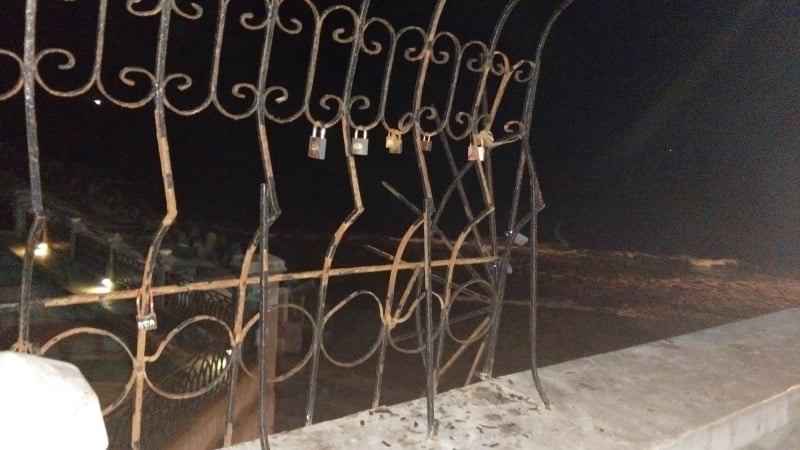
And the third time was on the wee hours of the 3rd of January when Adam brought our very own padlock to the famous bridge.

I was gently dosing at the back of the car. It was already 2am and the temperature dropped to four degrees outside.
I thought, Adam could be as romantic as he wants, but I’m going to keep my butt warm inside this car. Next thing I know, I wake up to this:

And a very giddy Adam and Anas were getting in the car just as a police officer started chasing them.
— Us.
The next day, we left Alexandria (and a possible vandalism charge) and stopped by a Gad restaurant for chicken shawarma before driving back home to Tanta. Stay tuned for the final part of the Enigmatic Egypt series.




